The city we’d chosen as our next destination point afterAcapulcowas popular among surfers Puerto Escondido located in 410 kilometers east from Acapulco. As we checked on the Internet, terrain seemed to be pretty even so we thought we could get there in three days.
Day 19.
We travel using our phones to navigate, although we have GPS unit we’ve never had the chance to use it. When you’re using your phone as GPS it is necessary to upload some maps on in order to save money on the road – we do this during staying in any cities that have free Internet access. Typically we are able to pass up to 150 kilometers per day so it makes sense to jump between small cities until we’ve got to some main point rather than try to camp anywhere on the road. So here is the schedule we had:
— Cruz Grande — 115 km
— Marquelia — 158 km
— Cuajinicuilapa — 220 km
— Santiago Pinotepa — 273 km
— Rio Grande — 363 km
— Puerto Escondido — 411 km
There were two ways to get out of our house on the coast from Acapulco to the road to Puerto Escondido. First way was just to climb up the hill from the coast on the height of about 200 meters above sea level, pass through the road tunnel, and that’s it. The second opportunity required us to pedal up to 10 km more, yet has a lot more interesting view as the road led us via the coast to the main street of the city, to go around the eastern cape and further along the coast to the track. We chose the second one.
Luis Miguel had been going to work when we got getting prept, He offered us to pick up our bags. We gladly agreed – we did not really want to rub brake shoes on the 10-degree slope. When our bikes were ready he asked to ride. He cycled for maybe two hundred meters on a straight line tumbling a bike side to side irresolutely.
— Well, for the first time it is a very unusual and difficult — he joked. We warmly said goodbye and left.
After we passed through all the main street of Acapulco, the road went uphill. To tell the truth, we did not expect such a long and steep climb. The morning sun was so hot that we were nonstop sweating. It took us an hour to overcome this climb, but we got great shots of Acapulco harbor — one of 5 the most beautiful harbors in the world, according to travelers’ stories.
An award for efforts was waiting for us on the slope. If not a convoy, which we caught up, we could develop higher speed, but the bike computer recorded 65 km / h.
We made the first stop for supplies and respite after 50 km, when got to the highway. While we were sitting on the steps of the store drinking water three cyclists had passed by in the same direction we were going. They were driving on a mountain bikes with 26'' wheels, and we decided that it would be easy to catch them.
After the break we moved on. We had to hurry, because we planned to make that huge 158 km distance. That was two hours before sunset and we had to pedal for another 60 km to Markel when my back wheel went flat. We stopped to pump it on a deserted road.
As we had to change the tube, the fact of impossibility of running 60 km before sunset was undeniable. There was some police truck parked nearby so we came to ask policemen about the nearest cities and distances to them. They told us that it would take us an hour by car. According to our data the nearest city was Cruz Grande located approximately 20 km down the road so we rushed there.
There was a village we were passing by where we met those three cyclists we had met on the road before. Those were guys from Mexico who travelled to some small town on the shore. As they usually passed no more than 50 km they were surprised hearing that our daily distance was supposed to be no less that 100 km. Well, time is money so we exchanged contacts and left.

As we spent a lot of time cruising in Acapulco and having the repair done, we were unable to carry our plan out. It took us about an hour to get to Cruz Grande where we spent night in one of those creepy hotels.
Day 20.
This was only second day of that run and although we were a bit behind the schedule we had a slight possibility of getting to Puerto Escondido in time. Subtracting dispensed by Google 115 km of the 273 km to Santiago Pinotepa, we had the same 158 km to go.
The road finally became worse. A narrow strip without any extra space and grainy asphalt with stones, cracks and pits did not allow us to keep necessary speed. Having lunch at a cafe in a nameless village, we noticed a mileage column with numbers 158 on it. This number seems to have become to hunt us.
Sunset brought closer and we were slowing down unable to deal with hills and bad road conditions. The town of Kuahinikuilapa was about 10 km ahead as our speed went down close to 10 km/h. We thought that it would be great if we reach that Kuahi-blah-blah and never mind those 158 km we’d planned! The journey was hard enough but on the other hand the landscapes along the road were beautiful — cow pastures on the broad green meadows, horse ranches, and a large beautiful lake!
Already at the city entrance we had flat tire again, but that time it was Vladimir’s bicycle. We weren’t even up to change the tube and after pumping the punctured one finally reached that day’s destination point but the plan to get to Puerto Escondido in 3 days failed.
Day 21.
In the morning we overslept and even left the room after checkout. Smiling old hotel owner was in no hurry to evict us, but rather sought to talk with us a little longer, but his wife always found for him to do the housework.
Next morning we had overslept and had to leave out hostel after checkout time. Nevertheless old man, who seemed to own that place didn’t want to get rid of us as soon as possible. Moreover he had been chatting with us while we were getting preptю Even his wife had no chance to load him with boring housework that time. Pity.
While we were changing the tube and packing clothes on the street a smart old man had managed to entertain himself and us.
— Where had you started?
— From Guadalajara.
— Wow! From Guadalajara, already got that far! And to where?
— To Argentina.
— To Argentina? (rolling his eyes) Que chingones!
Chingon — untranslatable Spanish slang, means something like fucking awesome! or in Russian, «офигеть!», but in the more restrictive version.
— I read a lot. — The hotel owner continued. — I read Gorky, Tolstoy, Chekhov, Dostoevsky. And I love to read Gabriel Garcia Marquez, you know? He is from Colombia. Did you know that Trotsky was murdered in Mexico? I know about Stalin and Lenin. Russians defeated Napoleon and Hitler! And now, from Mexico to Agrentina on bicycles! Que chingones rusos!
We had set the last — the fourth tube we had. The most of our tubes had blown after contact with metal things resembling a paper clip. Have no idea where did those things come from.
Luckily there was a bicycle store where bought a spare tube Then we had breakfast and left the city about 2 PM. We had only 3-4 hours before sunset meaning that we’re able to get only to Santiago Pinotepa 50 kilometers from Kuahinikuilapa.

After traveling a few miles, we crossed into the new state of Oaxaca. Contrary to our expectations, the road became worse, but there were new landscapes — tall grass along the road formed sort of a tunnel.
We got to the city quietly and with music, found the accommodation there, had dinner outside the kitchen on the main square and went to bed.
Day 22.
The distance to Puerto Escondido was about 140 km, and we were determined to complete this run in one day. We left the city even without breakfast thinking to eat on the road.
The path of the road was going downhill. After hitting the speed to «speed breaker» one spoke of Vladimir’s wheel had blown. Changing a broken spoke on the road is not the best opportunity, so we decided to get to the village. Waiting until Mexican eggs are cooked in a cafe, we examined the affected wheel. Well, honestly, wheel condition was poor but we couldn’t fix it ourselves. Moreover we did not want to get back to the city for the maintenance. We decided to try hitchhiking.
Almost half of the vehicles coming across on the slopes of Mexico were pickup trucks bringing mostly people who had been sitting tightly inside instead of some domestic crap or animals.
Almost half of the vehicles coming across on the slopes of Mexico were pickup trucks bringing mostly people who had been sitting tightly inside instead of some domestic crap or animals.
We drove a few miles from the village and settled down on the roadside. To make people take pity on us we put a bicycle so that it partially stuck out on the road and began hitchhiking. For a while we were standing, but no passing car even reduced the speed to pick us up.
— We did not mark time. We'll never catch. — experienced in these matters Vladimir said, who went round Europe hitchhiking twice.
The magic worked quickly. In less than 15 minutes after a battered pickup truck stopped. A middle-aged Mexican came out the car and said that he was going «to the village of Santa Rosa, an hour's drive from Puerto Escondido.» Of course we agreed. Pickup was extended, with the second row of seats. Bicycles and bags had been loaded into the truck, while we got into the cabin.
Despite open windows and the speed of 80-90 km/h, the cabin was hot. In Santa Rosa we said goodbye, ate watermelon and again left the village to continue hitchhiking.
This time we had to wait for a long time. Throughout the hour and a half only people wanting to earn extra money stopped. To Puerto Escondido we were announced the price of 1000 rubles. We disagreed on principle. We would not have gone even for 100 rubles, because the goal was to try «Mexican hitchhiking.»
One hour before sunset we’d been standing on the road, refusing to Mexican drivers. To the nearest city — Rio Grande – there were about 25 kilometers. We even thought to stop hitchhiking and cycle to the town to spend the night there. Suddenly, on the opposite road side, an old pickup truck stopped and an old Mexican looking out the window told us to wait until he turned around. He came back 5 minutes later and told us that at first he had driven by, and then thought he could help. He was just going to Rio Grande, but we agreed — it's better to get there by car than with a broken wheel. That time, truck had only one seat.
How many times had we envied Mexicans sprawled in pickups backs who swept past at speed! My little dream came true — to take a ride in the back of the truck. Vladimir was sitting all the way on the front seat entertaining a driver by conversations.
Time was close to dark and we were still in Rio Grande, we have decided to try our luck again and stood on the sidelines with a raised thumb. Pretty soon we had stopped white Nissan pickup with three guys in the front seats. They also traveled to Puerto Escondido and we agreed to be picked up. This time we both sat in the back of the truck.
When we had been flying at a speed of 100 km/h, the sun was setting. It was even a little bit cool — the first time for the whole trip we felt like to wear jackets. The sky and the landscape forecast ominously beautiful sunset there was.
Half an hour the winding hills and we were in Puerto Escondido. We did not have a place to live. We also did not know the area, but the guys dropped us off at the tourist street near the beach, told us in which direction we could find low-cost housing, and left.
We moved 100 meters from the beach, had dinner in a pizzeria and went to the ocean. Lying on the sand and looking at the starry sky, making plans for the next few days and thinking about where to celebrate the New Year. Nearby in the Mexican beach’s cafes people wearing Santa Claus’ cap had been celebrating Christmas.
comments powered by HyperComments















